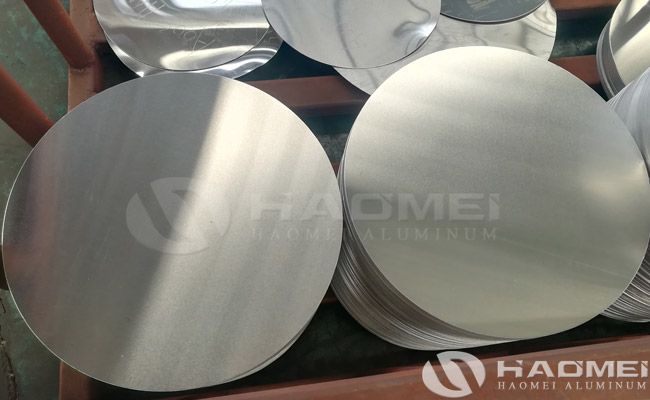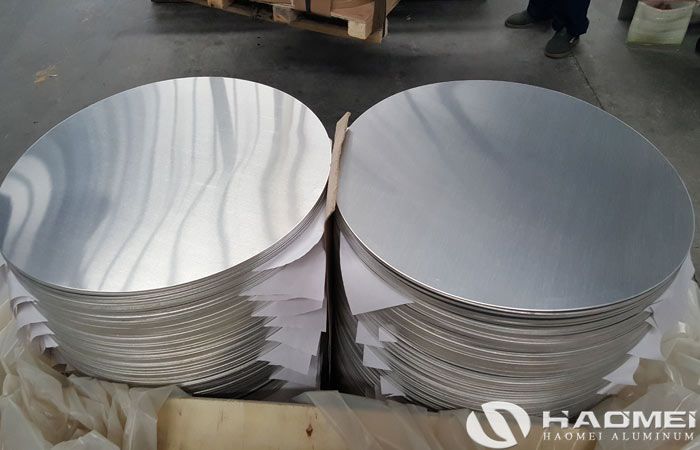DC aluminum discs and CC aluminum discs are aluminum discs produced under two different production processes. There are significant differences between hot-rolled aluminum discs and cast-rolled aluminum discs in production process, performance characteristics and application fields.

I. Production process comparison
- Process flow:
Aluminum ingot heating (500-550℃) → hot rolling (rolling into thick plates through multi-roll mills) → cold rolling (gradually thinning to target thickness) → annealing (eliminating work hardening and improving performance) → cutting into discs.
- Core features:
It needs to go through multiple rolling and annealing, with complex processes and long production cycles.
The processable thickness range is wide, suitable for medium and thick plate processing.
2. CC aluminum discs
- Process flow:
Aluminum liquid smelting (700-750℃) → Direct injection into casting and rolling mill (twin-roll continuous casting) → Rolling into thin strip billets → Cutting into discs (no annealing or only light annealing).
- Core features:
Ingot casting and rolling are completed simultaneously, short process production, high efficiency.
Suitable for thin-gauge products, thickness is usually ≤3mm.
II. Performance characteristics comparison
1. Thickness range
DC aluminum discs: 0.5-20mm (common 1-10mm)
CC aluminum discs: 0.1-3mm (common 0.2-1.5mm)
2. Mechanical properties
DC aluminum discs: high tensile strength, good ductility, suitable for deep processing
CC aluminum discs: low strength, moderate elongation, suitable for simple forming
3. Organization uniformity
DC aluminum discs: grain refinement, uniform organization, no casting defects
CC aluminum discs: may have slight segregation or pores (depending on process control)
4. Surface quality
DC aluminum discs: high surface finish, no obvious rolling lines
CC aluminum discs: there may be slight casting lines on the surface, which requires subsequent polishing
5. Dimensional accuracy
DC aluminum discs: small thickness tolerance (±0.02mm), high flatness
CC aluminum discs: The thickness tolerance is slightly larger (±0.05mm), and the edges are easy to curl
6. Oxide layer
DC aluminum discs: The oxide film is thin and uniform, suitable for surface treatment
CC aluminum discs: The oxide film is thicker and needs to be pre-treated to remove
III. Comparison of application fields
1. DC aluminum discs
- Industrial manufacturing:
Automotive parts (wheel hubs, engine housings), mechanical accessories (high-strength support parts are required).
Architectural decoration (curtain wall panels, ceilings), shipbuilding (corrosion-resistant structural parts).
- Deep processing scenarios:
Stretch forming (such as cooking utensils, lamp housings), welded components (high-toughness connections are required).
2. CC aluminum discs
- Packaging industry:
Aluminum foil blanks (food packaging, pharmaceutical packaging), bottle cap materials (can sealing sheets).
- Electronics and home appliances:
Radiator substrates (high thermal conductivity requirements, no high strength required), battery soft connectors.
- Lightweight scenarios:
Billboard substrates, thermal insulation materials (low strength requirements, focus on cost and processability).
IV. Comparison of cost and efficiency
1. DC aluminum discs:
- High cost: complex process, high energy consumption (requires multiple heating), high equipment investment.
- Low production efficiency: small single batch output, suitable for small batch customization needs.
2. CC aluminum discs:
- Low cost: short process production, 30%-50% energy saving, suitable for large-scale mass production.
- High production efficiency: 10-20 meters of strip can be rolled per minute, suitable for standardized products.
V. How to choose?
1. Choose DC aluminum discs:
- Require high strength, high toughness or complex forming (such as deep drawing, welding).
- Thickness ≥1mm, and strict requirements on dimensional accuracy.
2. Choose CC aluminum discs:
- Product thickness ≤1.5mm, focus on cost and production efficiency (such as packaging, electronic accessories).
- No high strength is required, only simple shearing or stamping is required.
VI. Industry Trends and Precautions
- Process Optimization: CC technology is developing towards ultra-thin (≤0.05mm) and high purity (99.99% or more), and can replace DC in some scenarios.
- Quality Control: DC needs to pay attention to the impact of annealing process on performance, and CC needs to control the purity of aluminum liquid to reduce defects.
- Environmental considerations: CC have low energy consumption and are more in line with the trend of green manufacturing, while DC requires supporting heat treatment waste gas treatment equipment.
Through the above comparison, a more suitable type of aluminum disc can be selected according to the performance requirements, cost budget and production scale of the specific application scenario.